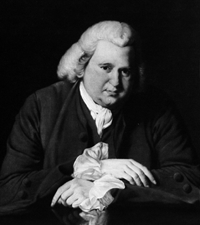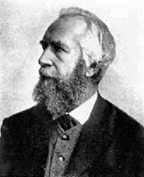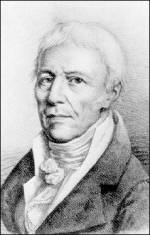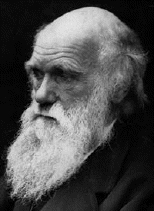19th Century Evolutionists, and Support for
Darwinian Evolution
 The physician
Erasmus Darwin, grandfather of Charles Darwin, offered in his ‘Zoonomia’ some
evolutionary speculations, but they were not further developed and had no real
influence on subsequent theories. The Swedish botanist Carolus Linneus devised
the hierarchical system of plant and animal classification that is still in use
in a modernized form. Although he insisted on the fixity of species, his
classification system eventually contributed much to the acceptance of the
concept of common descent. The physician
Erasmus Darwin, grandfather of Charles Darwin, offered in his ‘Zoonomia’ some
evolutionary speculations, but they were not further developed and had no real
influence on subsequent theories. The Swedish botanist Carolus Linneus devised
the hierarchical system of plant and animal classification that is still in use
in a modernized form. Although he insisted on the fixity of species, his
classification system eventually contributed much to the acceptance of the
concept of common descent.
The great
French naturalist Jean-Baptiste Lamarck held the enlightened view of his age
that living organisms represent a progression, with humans as the highest form.
From this idea he proposed, in the early years of the 19th century, the first
broad theory of evolution. Organisms evolve through eons of time from lower to
higher forms, a process still going on, always culminating in man. As organisms
become adapted to their environments through their habits, modifications occur.
Use of an organ or structure reinforces it; disuse leads to obliteration. The
characteristics acquired by use and disuse, according to this theory, would be
inherited. This assumption, later called the inheritance of acquired
characteristics, was thoroughly disproved in the 20th century. Although his
theory did not stand up in the light of later knowledge, Lamarck made important
contributions to the gradual acceptance of biological evolution and stimulated
countless later studies.
Darwin’s
Supporters and Predecessors:
Ernst Haeckel, the German biologist, was
influenced both by the German idealistic tradition and by the works of Darwin.
After reading Origin of Species, Haeckel became one of
the more prolific and vociferous supporters of evolution, but was less
supportive of natural selection as the mechanism by which evolution occurred.
Haeckel was certainly an evolutionist but less so a Darwinian.
An extremely
common misperception is that natural selection and evolution are the same
thing. In fact, Haeckel is one of many thinkers who believed that all species
were historical entities (lineages) but did not share Darwin's enthusiasm for
natural selection as the main mechanism for generating the diversity of the
biological world. Haeckel instead believed that the environment acted directly
on organisms, producing new races. The survival of the races did depend on
their interaction with the environment, a weak form of natural selection.
Haeckel's mechanism of change required that formation of new characters
diagnostic of new species occurred through progressive addition to the
developmental trajectory. For example, most metazoans go through a
developmental stage called a gastrula -- a ball of cells with an infolding that
later forms the gut. Haeckel thought that at one time an organism called a
"gastraea" existed that looked much like the gastrula stage of
ontogeny. This hypothesized ancestral metazoan gave rise to the rest of the
multi-cellular animals.
 Haeckel also
gave significant popular support to evolutionary theory with his elaborate
embryo set drawings, in which embryos of different organisms were drawn side by
side at different developmental stages, to show that their evolutionary history
(phylogeny) was recapitulated by their embryological development. Haeckel also
gave significant popular support to evolutionary theory with his elaborate
embryo set drawings, in which embryos of different organisms were drawn side by
side at different developmental stages, to show that their evolutionary history
(phylogeny) was recapitulated by their embryological development.
The "law
of recapitulation" has been discredited since the beginning of the
twentieth century. Experimental morphologists and biologists have shown that
there is not a one-to-one correspondence between phylogeny and ontogeny. This
was in part shown when it was realized that Haeckel had ‘adjusted’ many of his
embryo drawings to increase the apparent similarities. Although a strong form
of recapitulation is not correct, phylogeny and ontogeny are intertwined, and
many biologists are beginning to both explore and understand the basis for this
connection.
"Lamarckism" or "Lamarckianism" is now often used in a
rather derogatory sense to refer to the theory that acquired traits can be
inherited. What Lamarck actually believed was more complex: organisms are not
passively altered by their environment. Instead, a change in the environment
causes changes in the needs of organisms living in that environment, which in
turn causes changes in their behavior. Altered behavior leads to greater or
lesser use of a given structure or organ; use would cause the structure to
increase in size over several generations, whereas disuse would cause it to
shrink or even disappear. This rule -- that use or disuse causes structures to
enlarge or shrink -- Lamarck called the "First Law" in his book Philosophie
zoologique. Lamarck's "Second Law" stated that all such changes
were heritable. The result of these laws was the continuous, gradual change of
all organisms, as they became adapted to their environments; the physiological
needs of organisms, created by their interactions with the environment, drive
Lamarckian evolution.
While the
mechanism of Lamarckian evolution is quite different from that proposed by
Darwin, the predicted result is the same: adaptive change in lineages,
ultimately driven by environmental change, over long periods of time. It is
interesting to note that Lamarck cited in support of his theory of evolution
many of the same lines of evidence that Darwin was to use in the Origin of
Species. Lamarck's Philosophie zoologique mentions the great variety
of animal and plant forms produced under human cultivation (Lamarck even
anticipated Darwin in mentioning fantail pigeons!); the presence of vestigial,
non-functional structures in many animals; and the presence of embryonic
structures that have no counterpart in the adult. Like Darwin and later
evolutionary biologists, Lamarck argued that the Earth was immensely old.
Lamarck even mentions the possibility of natural selection in his writings, although
he never seems to have attached much importance to this idea.
It is even
more interesting to note that, although Darwin tried to refute the Lamarckian
mechanism of inheritance, he later admitted that the heritable effects of use
and disuse might be important in evolution. In the Origin of Species he
wrote that the vestigial eyes of moles and of cave-dwelling animals are
"probably due to gradual reduction from disuse, but aided perhaps by
natural selection." Lamarckian inheritance, at least in the sense Lamarck
intended, is in conflict with the findings of genetics and has now been largely
abandoned -- but until the rediscovery of Mendel's laws at the beginning of the
twentieth century, no one understood the mechanisms of heredity, and Lamarckian
inheritance was a perfectly reasonable hypothesis. Several other scientists of
the day subscribed to the theory of use and disuse -- in fact, Erasmus Darwin's
evolutionary theory is so close to Lamarck's in many respects that it is
surprising that, as far as is known now, the two men were unaware of each
other's work.
 In several
other respects, the theory of Lamarck differs from modern evolutionary theory.
Lamarck viewed evolution as a process of increasing complexity and
"perfection," not driven by chance; as he wrote in Philosophie
zoologique, "Nature, in producing in succession every species of
animal, and beginning with the least perfect or simplest to end her work with
the most perfect, has gradually complicated their structure." Lamarck did
not believe in extinction: for him, species that disappeared did so because
they evolved into different species. If this goes on for too long, it would
mean the disappearance of less "perfect" organisms; Lamarck had to
postulate that simple organisms, such as protists, were constantly being
spontaneously generated. Yet despite these differences, Lamarck made a major
contribution to evolutionary thought, developing a theory that paralleled
Darwin's in many respects. Rediscovered in the middle part of the 19th century,
his theories finally gained the attention they merited. His mechanism of
evolution remained a popular alternative to Darwinian selection until the
beginning of the 20th century; prominent scientists like Edward Drinker Cope
adopted Lamarckianism and tried to apply it to their work. Though his proposed
mechanism eventually fell out of favor, he broke ground in establishing the
fact of evolution. In several
other respects, the theory of Lamarck differs from modern evolutionary theory.
Lamarck viewed evolution as a process of increasing complexity and
"perfection," not driven by chance; as he wrote in Philosophie
zoologique, "Nature, in producing in succession every species of
animal, and beginning with the least perfect or simplest to end her work with
the most perfect, has gradually complicated their structure." Lamarck did
not believe in extinction: for him, species that disappeared did so because
they evolved into different species. If this goes on for too long, it would
mean the disappearance of less "perfect" organisms; Lamarck had to
postulate that simple organisms, such as protists, were constantly being
spontaneously generated. Yet despite these differences, Lamarck made a major
contribution to evolutionary thought, developing a theory that paralleled
Darwin's in many respects. Rediscovered in the middle part of the 19th century,
his theories finally gained the attention they merited. His mechanism of
evolution remained a popular alternative to Darwinian selection until the
beginning of the 20th century; prominent scientists like Edward Drinker Cope
adopted Lamarckianism and tried to apply it to their work. Though his proposed
mechanism eventually fell out of favor, he broke ground in establishing the
fact of evolution.
Support for
Darwinian evolution:
Embryology and
Comparative Anatomy:
Darwin and his followers found support for
evolution in the comparative study of embryology. Chordates develop in ways
that are remarkably similar during early stages, but they become more and more
differentiated as the embryos approach maturity. The similarities persist longer
between organisms that are more closely related than between those less closely
related. Common developmental patterns reflect evolutionary proximity. Lizards
and humans share developmental patterns inherited from their common ancestor;
the inherited pattern was modified only as the separate descendant lineages
evolved in different directions. The common embryonic stages of the two
creatures reflect the constraints imposed by this common inheritance, which
prevents changes that have not been necessitated by their diverging environment
and way of life.
Human and other
non-aquatic embryos exhibit gill slits even though they never breathe through
gills. These slits are found in the embryos of all vertebrates because they
share as common ancestors the fish in which these structures first evolved.
Human embryos also exhibit by the fourth week of development a well-defined
tail, which reaches maximum length when the embryo is six weeks old. Similar
embryonic tails are found in other mammals, such as dogs, horses, and monkeys;
in humans, however, the tail eventually shortens, persisting only as a rudiment
in the adult coccyx.
A close
evolutionary relationship between organisms that appear drastically different
as adults can sometimes be recognized by their embryonic homologies. Barnacles
are sedentary crustaceans with little apparent likeness to such crustaceans as
lobsters, shrimps, or copepods. Yet barnacles pass through a free-swimming
larval stage, the nauplius, which is unmistakably similar to other crustacean
larvae.
Embryonic
rudiments that never fully develop, such as the gill slits in humans, are
common in all sorts of animals. Some, however, like the tail rudiment in
humans, persist as adult vestiges reflecting evolutionary ancestry. The most
familiar rudimentary organ in humans is the appendix. This worm-like structure
attaches to the cecum, which is located at the point where the ileum and colon
join. The human vermiform appendix is a functionless vestige of a fully
developed organ present in other mammals, such as the rabbit and other
herbivores, where a large cecum and appendix store vegetable cellulose to
enable its digestion with the help of bacteria. Vestiges are instances of
imperfections that argue against creation by design but are fully understandable
as a result of evolution.
Comparative
anatomy investigates the homologies, or inherited similarities, among organisms
in bone structure and in other parts of the body. The correspondence of
structures is typically very close among some organisms--the different
varieties of songbirds, for instance--but becomes less so as the organisms
compared are less closely related in their evolutionary history. The
similarities are less detailed between mammals and birds than they are among
mammals, and less yet between mammals and fishes. Similarities in structure,
therefore, not only manifest evolution but also help to reconstruct the
phylogeny, or evolutionary history, of organisms.
An explanation of why most organismic
structures are not perfect is also revealed by comparative anatomy. Like the
forelimbs of turtles, horses, humans, birds, and bats, an organism's body parts
are less than perfectly adapted because they are modified from an inherited
structure rather than designed from completely "raw" materials for a
specific purpose. The imperfection of structures is evidence for evolution and
against design.
Paleontology
and the Fossil Record:
Radioactive
dating indicates that the Earth was formed about 4,500,000,000 years ago. The
earliest fossils resemble prokaryotic microorganisms such as bacteria and
blue-green algae; the oldest ones appear in rocks 3,500,000,000 old. The oldest
(post Ediacaran) animal fossils, about 700,000,000 years old, come from small
wormlike creatures with soft bodies and skeletal plates (the small shelly
fauna). Numerous fossils belonging to many living phyla and exhibiting
mineralized skeletons appear in rocks about 570,000,000 years old (Burgess
shale). These organisms are different from organisms living now and from those
living at intervening times. Some are so radically different that
paleontologists have created new phyla in order to classify them. The first
craniate chordates appeared about 400,000,000 years ago; the first mammals less
than 200,000,000 years ago. The history of life recorded by fossils presents
compelling evidence of evolution.
The lower jaw of all non synapsid
tetrapods contains several bones, that of mammals only one; the other bones in
the diapsid jaw evolved into bones now found in the mammalian ear.
Paleontologists discovered two transitional forms of therapsids with a double
jaw joint--one joint consisting of the bones that persist in the mammalian jaw,
the other composed of the quadrate and articular bones, which eventually became
the hammer and anvil of the mammalian ear.
Biogeography:
 Darwin also saw a confirmation of evolution in the
geographic distribution of plants and animals, and later knowledge has
reinforced his observations. For example, there are about 1,500 species of Drosophila
flies in the world; nearly one-third of them live in Hawaii and nowhere else,
although the total area of the archipelago is less than one-twentieth the area
of California. There are also in Hawaii more than 1,000 species of snails and
other land mollusks that exist nowhere else. This unusual diversity is easily
explained by evolution. The Hawaiian Islands are extremely isolated and have
had few colonizers; those species that arrived there found many unoccupied
ecological niches, or local environments suited to sustain them and lacking
predators that would prevent them from multiplying. In response, they rapidly
diversified; this process of diversifying in order to fill in ecological niches
is called adaptive radiation. Darwin also saw a confirmation of evolution in the
geographic distribution of plants and animals, and later knowledge has
reinforced his observations. For example, there are about 1,500 species of Drosophila
flies in the world; nearly one-third of them live in Hawaii and nowhere else,
although the total area of the archipelago is less than one-twentieth the area
of California. There are also in Hawaii more than 1,000 species of snails and
other land mollusks that exist nowhere else. This unusual diversity is easily
explained by evolution. The Hawaiian Islands are extremely isolated and have
had few colonizers; those species that arrived there found many unoccupied
ecological niches, or local environments suited to sustain them and lacking
predators that would prevent them from multiplying. In response, they rapidly
diversified; this process of diversifying in order to fill in ecological niches
is called adaptive radiation.
The continents of the world have their
own distinctive fauna and flora. In Africa there are rhinoceroses,
hippopotamuses, lions, hyenas, giraffes, zebras, lemurs, monkeys with narrow
noses and non-prehensile tails, chimpanzees, and gorillas. South America, which
extends over much the same latitudes as Africa, has none of these animals but
has different ones: pumas, jaguars, tapirs, llamas, raccoons, opossums,
armadillos, and monkeys with broad noses and large prehensile tails.
These
vagaries of biogeography are not due solely to the suitability of the different
environments. There is no reason to believe that South American animals are not
well suited to live in Africa or those of Africa to live in South America. The
Hawaiian Islands are no better suited than other Pacific islands for Drosophila
flies, nor are they less hospitable than other parts of the world for many
absent organisms. In fact, although no large mammals are native to the islands,
pigs and goats have multiplied there as wild animals since being introduced by
humans. This absence of many species from a hospitable environment in which an
extraordinary variety of other species flourishes can be explained by the
theory of evolution, which holds that species can exist and evolve only in
geographic areas that were colonized by their ancestors.
Molecular Biology:
It is now
known that DNA and the enzymes that govern all life processes hold information
about an organism's ancestry. This information has made it possible to
reconstruct evolutionary events that were previously unknown and to confirm and
adjust the view of events that already were known. The precision with which
events of evolution can be reconstructed is one reason the evidence from
molecular biology is so compelling. Another reason is that molecular evolution
has shown all living organisms, from bacteria to humans, to be related by
descent from common ancestors.
A remarkable
uniformity exists in the molecular components of organisms--in the nature of
the components as well as in the ways in which they are assembled and used. In
all bacteria, plants, animals, and humans, the DNA comprises a different
sequence of the same four component nucleotides, and all of the various
proteins are synthesized from different combinations and sequences of the same
20 amino acids, although several hundred other amino acids do exist. The
genetic code by which the information contained in the nuclear DNA is passed on
to proteins is everywhere the same. Similar metabolic pathways are used by the
most diverse organisms to produce energy and to make up the cell components.
This unity
reveals the genetic continuity and common ancestry of all organisms. There is
no other rational way to account for their molecular uniformity when numerous
alternative structures are equally likely. The genetic code may serve as an
example. Each particular sequence of three nucleotides in the nuclear DNA acts
as a pattern, or code, for the production of exactly the same amino acid in all
organisms.
The evidence
of evolution revealed by molecular biology goes one step further. The degree of
similarity in the sequence of nucleotides or of amino acids can be precisely
quantified. For example, cytochrome-c of humans and chimpanzees consists of the
same 104 amino acids in exactly the same order; but differs from that of rhesus
monkeys by one amino acid, that of horses by 11 additional amino acids, and
that of tuna by 21 additional amino acids. The degree of similarity reflects
the recency of common ancestry. Thus, the inferences from comparative anatomy
and other disciplines concerning evolutionary history can be tested in
molecular studies of DNA and proteins by examining their sequences of
nucleotides and amino acids.
The authority
of this kind of test is overwhelming; each of the thousands of genes and
thousands of proteins contained in an organism provides an independent test of
that organism's evolutionary history. Not all possible tests have been
performed, but many hundreds have been done, and not one has given evidence
contrary to evolution. There is probably no other notion in any field of
science that has been as extensively tested and as thoroughly corroborated as
the evolutionary origin of living organisms.
© 2001 Patrick Mellor, University of Oxford.
- Metazoans: Animals which have many cells and have a digestive cavity - back
- Ontogeny: Life history of individual organism - back
- Protists: Single and multicellular organisms that are plant-like, animal-like and fungi-like - back
- Chordates: Large phylum comprising the animals that possess a rod of flexible tissue, which is protected in higher forms by a vertebral column - back
- Homologies: Similarities in DNA or protein sequences between individuals or between species - back
- Prokaryotic: Having cells that lack membrane-bound nuclei - back
- Phyla: A primary division of a kingdom, as of the animal kingdom, ranking next above a class in size - back
- Synapsid: Extinct reptile having a single pair of lateral temporal openings in the skull - back
- Tetrapod: Having four feet, legs, or leglike appendages - back
- Diapsid: Any of various reptiles having a skull with two pairs of temporal openings and including the lizards, snakes, crocodiles, and dinosaurs - back
- Therapsids: Extinct mammal-like reptiles found inhabiting all continents from the mid Permian to late Triassic - back
- Prehensile: Adapted for seizing, grasping, or holding, especially by wrapping around an object - back
- Nucleotides: The basic building blocks of nucleic acids - back
|